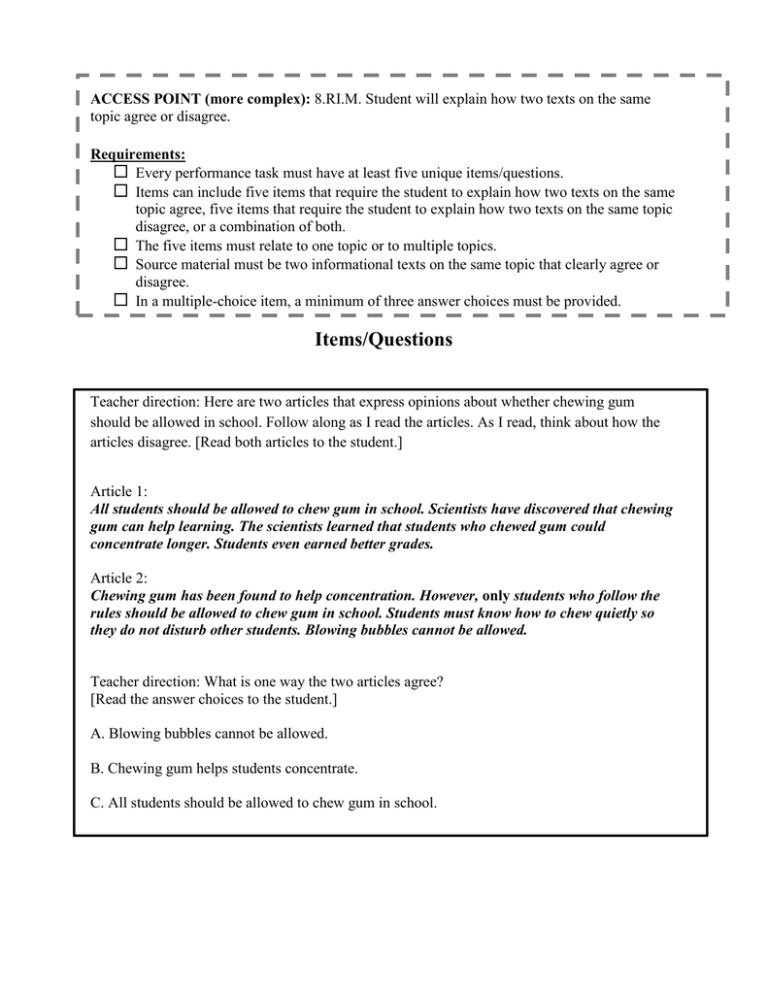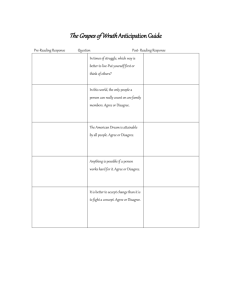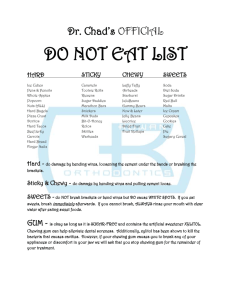Items/Questions
advertisement

ACCESS POINT (more complex): 8.RI.M. Student will explain how two texts on the same topic agree or disagree. Requirements: Every performance task must have at least five unique items/questions. Items can include five items that require the student to explain how two texts on the same topic agree, five items that require the student to explain how two texts on the same topic disagree, or a combination of both. The five items must relate to one topic or to multiple topics. Source material must be two informational texts on the same topic that clearly agree or disagree. In a multiple-choice item, a minimum of three answer choices must be provided. Items/Questions Teacher direction: Here are two articles that express opinions about whether chewing gum should be allowed in school. Follow along as I read the articles. As I read, think about how the articles disagree. [Read both articles to the student.] Article 1: All students should be allowed to chew gum in school. Scientists have discovered that chewing gum can help learning. The scientists learned that students who chewed gum could concentrate longer. Students even earned better grades. Article 2: Chewing gum has been found to help concentration. However, only students who follow the rules should be allowed to chew gum in school. Students must know how to chew quietly so they do not disturb other students. Blowing bubbles cannot be allowed. Teacher direction: What is one way the two articles agree? [Read the answer choices to the student.] A. Blowing bubbles cannot be allowed. B. Chewing gum helps students concentrate. C. All students should be allowed to chew gum in school. Teacher direction: Follow along as I read two articles about wind power. As I read, think about how the articles agree. [Read the articles to the student. Provide word banks relating to the topic for the student to use in the response.] Article 1 Using Wind Power Wind power is popular in many countries including the United States. However, the United States does not use wind power as much as other countries. There are many reasons for this. One is that it is expensive to build the machines used for wind power. Another reason is that the machines can cause problems for birds migrating throughout the year. Finally, the wind does not always blow, which could make it hard to get wind power. Article 2 The Power of Wind Wind power is becoming more and more popular in the United States. People like that wind power does not cause pollution. The machines used for wind power used to be very expensive, but they are not as expensive now. Unfortunately wind power does have some problems. The machines used for wind power can harm birds as they migrate. Another problem is that the wind isn’t always blowing. That means people will have to use another way to get power. Teacher direction: What is one way the two articles agree? [Read the answer choices to the student.] A. Wind power can cause problems for migrating birds. B. Wind power causes air pollution. C. Wind power is not popular in the United States. Teacher direction: Here are two articles that express opinions about school homework. Follow along as I read the articles. As I read, think about how the articles disagree. [Read both articles to the student.] Article 1: I think students should have homework every day. Homework helps students remember what they learn in class. Homework will make students smarter. Article 2: Teachers should not give out homework. Students need a break from school work when they go home. Too many students stay up late to finish all of their homework and then do not get enough time for a good night’s sleep. Teacher direction: What is one way the two articles disagree? [Read the answer choices to the student.] A. Students should eat a healthy breakfast. B. Students should do homework every day. C. Student’s need a good night’s sleep. Teacher direction: Here are two articles that express opinions about cell phones in school. Follow along as I read the articles. As I read, think about how the articles disagree. [Read both articles to the student.] Article 1: Students should be allowed to use cell phones in school. Most cell phones are mini computers. Students can use these to look up information for school assignments. Students can also use the phones to have anonymous class discussions with the teacher. Article 2: Students should not have cell phones in school. Cell phones are distracting. Students should be doing their assignments and not texting their friends. Students can use cell phones to pass answers to each other or look up answers on the internet. Teacher direction: What is one way the two articles disagree? [Read the answer choices to the student.] A. There are many different types of cell phones. B. Students should be doing their class assignments. C. Students should be allowed to have cell phones in school.






